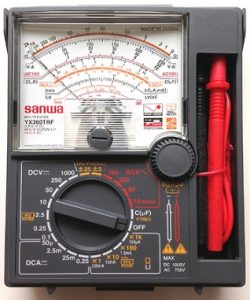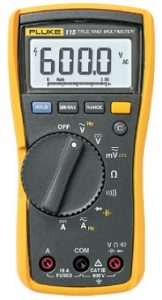A measuring device like a multimeter is an essential device in the field of electronics and electrical labs or workshops to measure the electrical properties of industrial wiring as well as tools. Before knowing about this device, some fundamental concepts we have to know like the voltage, current, and resistance.
Here, voltage is the disparity in charge between the two points, the current is nothing but the flow of charge carriers and resistance is the measure of the current flow. At present, these are available in the market with several functions based on necessity. This article discusses an overview of multimeter and its working with types.
What is Multimeter?
A measuring instrument that is used to measure different electrical properties like resistance, voltage and current is known as a multimeter. This is also called a VOM or volt-ohm-milliammeter. This instrument plays a key role in finding the issues that occurred in the circuits so that we can easily troubleshoot the issues. Multimeter includes a rotary switch on the front panel, used to select different electrical parameters to measure electrical properties. These are classified into two types like analog and digital which are discussed below.

Multimeter
The multimeter diagram is shown above that includes three parts like display, knob, and ports. Generally, the display on the multimeter includes 4 digits which display a negative sign. Some types of meters include illuminated displays which display clearly in less light conditions. The selection knob is used to allow the operator to fix the multimeter to examine several parameters like current, voltage, and resistance.
The multimeter has two probes like black and white which are inserted into two ports on the front side of the meter. Here, a common or COM probe is used to connect the GND of a circuit. This kind of probe is usually in black color however there is no dissimilarity among the two probes like red and black except the color.
A special port on the multimeter like 10A is mainly used where the measurement of a large current is required above 200mA. The port-like mAVΩ is used to place the red probe into it to measure up to 200mA of current, resistance, and voltage. These probes include a connector in the banana shape on the end-user to plug on the multimeter.
Types of Multimeter
There are different kinds of multimeters available in the market like analog and digital. Previously, analog multimeter was used however at present digital multimeters are used broadly because it is simple to handle.
Analog Multimeter
An Analog multimeter or a moving coil device works with a microammeter and a needle to calculate different parameters like voltage, current, etc. The display of this meter depends on a microammeter where the needle moves on an adjusted scale for different measurements. By using this, you can simply calculate different quantities by modifying the setting of the switch otherwise range on the meter with the help of several removable probes.

Analog Multiplier
These types of multimeters are responsive more for the changes as compared to digital multimeters, therefore it is capable to provide a more precise reading. But, it is very responsive; so it is tough to read & provide delays.
Digital Multimeter
A measuring instrument like a digital multimeter is the most frequently used test equipment in different industries. This device includes an LCD screen as well as a frequency selector switch to give an output directly within a decimal form.

Digital Multimeter
This multimeter provides better accuracy by obtaining various signal samples in less duration of time. This meter also provides an automatic ranging feature so that the operator does not require choosing the measurement physically. At present, digital multimeters are playing an essential role as compared to analog due to quick response, accuracy, LCD display screen, and many more.
Fluke Multimeter
This multimeter is designed with a variety of functions. Usually, this meter comprises a big display. This device is used to calculate the resistance and voltage. There are some devices are available including several features to calculate duty cycle, frequency temperature, humidity, pressure, etc. This is the most frequently used instrument.
This is used to adjust different parameters like volts, current and electrical unit. The protection of the fluke multimeter can be done from the transient voltage. This is a portable instrument and used to measure current, voltage and also to check diodes.
This multimeter includes different selectors to choose the preferred function. This meter ranges automatically chooses most of the measurements which mean, the signal’s magnitude has to determine to take a precise reading, so it is moved openly to the appropriate port for the selected measurement. This multimeter is protected to keep away from damage if it is connected to the incorrect port.
Clamp Multimeter
The clamp multimeter is mainly used to measure the flow of electricity. This kind of multimeter comprises the clamp feature to calculate the amps once the two probes calculate the volts. The power consumption adjustment can be done by multiplying the voltage reading through the amps. This kind of multimeter also comprises an extra feature like different types of settings. So from that, a suitable setting can be used when measuring.
The flow of current can be measured by using this multimeter with fixed tools. So, this instrument changes extremely from the fluke type because, in fluke type, it uses a clamp feature to calculate the current flow. Thus this kind of device is recommended for experts regularly.
Autoranging Multimeter
This is a simple type multimeter but expensive as compared to other types. This kind of multimeter comprises a knob in the middle & includes less position. So it doesn’t control by design to measure but this device is used in simple electronic projects. These instruments are recommended highly for electricians and beginners. Normally, this meter measures only one component at a time.
Precautions
The following precautions must be taken while using the multimeter
- While using a multimeter, the probe’s ends must be cleaned otherwise the insulation will be deposited.
- Multimeter should not connect with an AC circuit because it cannot measure directly
- While measuring voltage & current, fix the selector switch at the maximum range, after that it can be decreased to low according to the necessity.
- While measuring the resistance value, the resistor must take apart from the circuit as well as the power supply can be detached from the meter. After that, the value of resistance must be calculated.
- Do not utilize this meter for measuring high range of current than the fixed range.
- Before using this meter, make sure that the pointer must be set to zero position once two probes are placed together.
How to use a Multimeter?
Multimeters can be used to measure different parameters like voltage, current, and resistance. Before measuring different parameters, it is significant to recognize how to check the stability of the circuit. The circuit stability allows you to notice bugs so that we can troubleshoot the circuit. This allows an extremely less quantity of current to supply without resistance.
- Before using a multimeter, the following steps need to follow.
- Switch ON the Multimeter
- Place two probes into the exact connections because there are different connections that can be used for different purposes
- Set the switch to the exact type of measurement & range. Once the range is selected then make sure that the highest range is above that expected. We can reduce the range on the multimeter if necessary. But by choosing a high range, the meter will be stopped from overload.
- For the finest reading, the range must be optimized.
- When the reading is completed, insert the probes into the sockets of voltage measurement & switch the range to the highest voltage.
- In this method, if the multimeter is connected unexpectedly without selecting the range then there will be a little chance to damage the multimeter
Voltage Measurement
- The voltage measurement like AC or DC voltage can be done using a multimeter. Here AC voltage is nothing but the voltage ‘V’ through the wavy line whereas DC voltage is the voltage ‘V’ with a straight line.
- To measure the voltage, set the voltage mode to ‘V’ based on AC or DC.
- Check the red probe is connected to the port through a V after that to it or not
- Fix the red color probe to the positive face of your required component, where the flow of current is supplying from other faces of your required component, fix the COM probe.
- To calculate the voltage, first, we have to fix the multimeter within parallel through the component we desire to calculate the voltage. Arranging this meter within parallel is locating every probe with the component’s leads you desire to calculate the voltage.
Current Measurement
To calculate current using a multimeter, we need to accept in mind that components that are connected in series have a flow of current. So, the connection of the multimeter to the circuit can be done in series.
For that, we need to place the red color probe on the component’s terminal whereas the black color probe should connect to the next terminal of the same component.
The multimeter works like a wire within the circuit. If the multimeter is disconnected then the circuit will not work. So the current can be measured by inserting the probe within the right-side port that is µA or mA.
Resistance Measurement
Place the red color probe on the terminals of the resistor. The result will be the same if you connect the two leads in any manner.
Advantages
The advantages of a multimeter include the following.
- High accuracy
- High input impedance so there is no effect for loading
- A clear reading at higher viewing distances can be obtained.
- The electrical output can be used to interface with additional equipment
- These are less costly due to the integrated technology
- Output display can be provided automatically.
- It includes auto polarity functions.
Disadvantages
The disadvantages of a multimeter include the following.
- As compared to analog type, it is expensive
- The power supply requirement & isolation issues
- It does not perform well through measurement fluctuations.
- The LCD display mainly depends on an external power source like a battery because once the battery is discharged, then the LCD will be dim, so it is difficult to read.
- The limitation of the meter is 1V, so if the limitation increases then the multimeter will get damage
- The meter must be used as per the specified measurement of the manufacturer as well as the rating of category; otherwise, the meter will be damaged so it causes loss to the equipment.
Applications of Multimeter
The uses of multimeter include the following.
- AC/DC voltage measurement
- AC/DC current measurement
- Resistance & continuity measurement
- To check diode
- Measurement of capacitance
- Measurement of frequency
- To test batteries
- A broken power cable can be determined
- The switch can be tested
- An outlet can be tested
- Old incandescent type light bulbs can be tested
- It is used in the applications of environmental and temperature
- Measurement of time & frequency
Please refer to this link to know more about Clamp Meter & Anemometer.
Please refer to this link to know more about Measurement and Instrumentation MCQs.
Please refer to this link to know more about Multimeter MCQs
Thus, this is all about an overview of multimeter, types & working with applications. This is also called a volt-ohm meter, used to compute electrical resistance, voltage & current. These are available in two types like analog & digital which are used for calculating battery voltage, fault detecting & complex diagnostics. These instruments are used by electricians to troubleshoot electrical issues on circuits, motors, wiring systems, power supplies, appliances, etc. Here is a question for you, what is a Meco multimeter?